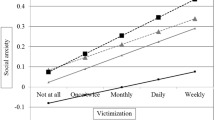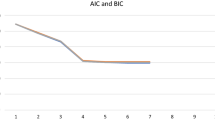Abstract
This study tested a person–group dissimilarity model for the relation between peer preference on the one hand, and bullying and victimization on the other. This model accounts for both individual and group (i.e., classroom) factors and postulates that children will be rejected by their peers when they display behaviors that deviate from the group norm. We tested the model in a sample of 2,578 early adolescents in 109 middle school classrooms. Multilevel analysis was used to account for our nested data when examining individual and group effects simultaneously in cross-level interaction terms. The results supported our hypotheses based on the dissimilarity model. Classroom norms of behavior appeared to affect the relation between involvement in bullying and peer preference, in that early adolescents who bullied were more likely to be rejected by their peers in a classroom where bullying was non-normative. In classrooms where bullying was normative, adolescents who bullied were less likely to be rejected or were even liked by their peers (i.e., positive scores on peer preference). The same was true for victimization, although victims still had low scores on peer preference even when victimization was normative. Theoretical and practical implications of these results are discussed in terms of directions for future research and intervention in bullying.


Similar content being viewed by others
References
Bellmore, A., Witkow, M., Graham, S., & Juvonen, J. (2004). Beyond the individual: The impact of ethnic context and classroom behavioral norms on victims’ adjustment. Developmental Psychology, 40, 1159–1172.
Boivin, M., Dodge, K. A., & Coie, J. D. (1995). Individual-group behavioral similarity and peer status in experimental play groups of boys: The social misfit revisited. Journal of Personality and Social Psychology, 69, 269–279.
Boulton, M. J., & Smith, P. K. (1994). Bully/victim problems in middle school children: Stability, self-perceived competence, peer perceptions and peer acceptance. British Journal of Developmental Psychology, 12, 315–329.
Bukowski, W. M., & Newcomb, A. F. (1984). Stability and determinants of sociometric status and friendship choice: A longitudinal perspective. Developmental Psychology, 20, 941–952.
Burnham, K. P., & Anderson, D. R. (2004). Multimodel inference: Understanding AIC and BIC in model selection. Sociological Methods & Research, 33, 261–304.
Cairns, R. B., Cairns, B. D., Neckerman, H. J., Gest, S. D., & Gariépy, J. (1988). Social networks and aggressive behavior: Peer support or peer rejection? Developmental Psychology, 24, 815–823.
Chang, L. (2004). The role of classroom norms in contextualizing the relations of children’s social behaviors to peer acceptance. Developmental Psychology, 40, 691–702.
Coie, J. D., & Dodge, K. A. (1983). Continuities and changes in children’s social status: A five-year longitudinal study. Merril-Palmer Quarterly, 29, 261–282.
DeRosier, M. E., Cillessen, A. H. N., Coie, J. D., & Dodge, K. A. (1994). Group social context and children’s aggressive behavior. Child Development, 65, 1068–1079.
Dodge, K. A., Coie, J. D., Pettit, G. S., & Price, J. M. (1990). Peer status and aggression in boys’ groups: Developmental and contextual analyses. Child Development, 61, 1289–1309.
Eslea, M., Menesini, E., Morita, Y., O’Moore, M., Mora-Merchán, J. A., Pereira, B., et al. (2004). Friendship and loneliness among bullies and victims: Data from seven countries. Aggressive Behavior, 30, 71–83.
Espelage, D. L., Holt, M. K., & Henkel, R. R. (2003). Examination of peer–group contextual effects on aggression during early adolescence. Child Development, 74, 205–220.
Farmer, T. W., & Rodkin, P. C. (1996). Antisocial and prosocial correlates of classroom social positions: The social network centrality perspective. Social Development, 5, 174–188.
Jackson, M. F., Barth, J. M., Powell, N., & Lochman, J. E. (2006). Classroom contextual effects of race on children’s peer nominations. Child Development, 77, 1325–1337.
Killen, M., Crystal, D. S., & Watanabe, H. (2002). Japanese and American children’s evaluations of peer exclusion, tolerance of differences, and prescriptions for conformity. Child Development, 73, 1788–1802.
Ladd, G. W. (1983). Social Networks of popular, average, and rejected children in school settings. Merrill-Palmer Quarterly, 29, 283–307.
LaFontana, K. M., & Cillessen, A. H. N. (2002). Children’s perceptions of popular and unpopular peers: A multimethod assessment. Developmental Psychology, 38, 635–647.
Lagerspetz, K. M. J., Björkqvist, K., Berts, M., & King, E. (1982). Group aggression among school children in three schools. Scandinavian Journal of Psychology, 23, 45–52.
Lee, V. E. (2000). Using hierarchical linear modeling to study social contexts: The case of school effects. Educational Psychologist, 35, 125–141.
Miller-Johnson, S., Coie, J. D., Maumary-Gremaud, A., Bierman, K., & the Conduct Problems Prevention Research Group (2002). Peer rejection and aggression and early starter models of conduct disorder. Journal of Abnormal Child Psychology, 30, 217–230.
Newcomb, A. F., & Bukowski, W. M. (1983). Social impact and social preference as determinants of children’s peer group status. Developmental Psychology, 19, 856–867.
Newcomb, A. F., Bukowski, W. M., & Pattee, L. (1993). Children’s peer relations: A meta-analytic review of popular, rejected, neglected, controversial, and average sociometric status. Psychological Bulletin, 113, 99–128.
Olweus, D. (1989). The Olweus Bully/victim Questionnaire. Bergen, Norwegen: Mimeo.
Olweus, D. (1993). Bullying at school. Cambridge, MA: Blackwell.
Parker, J. G., & Asher, S. R. (1987). Peer relations and later personal adjustment: Are low-accepted children at risk? Psychological Bulletin, 102, 357–389.
Pellegrini, A. D. (1995). A longitudinal study of boys’ rough-and-tumble play and dominance during early adolescence. Journal of Applied Developmental Psychology, 16, 77–93.
Pellegrini, A. D. (1998). Bullies and victims in school : A review and call for research. Journal of Applied Developmental Psychology, 19, 165–176.
Pellegrini, A. D., Bartini, M., & Brooks, F. (1999). School bullies, victims, and aggressive victims: Factors relating to group affiliation and victimization in early adolescence. Journal of Educational Psychology, 91, 216–224.
Prinstein, M. J., & Cillessen, A. H. N. (2003). Forms and functions of adolescent peer aggression associated with high levels of peer status. Merril-Palmer Quarterly, 49, 310–342.
Rasbash, J., Browne, W., Goldstein, H., Yang, M., Plewis, I., Healy, M., et al. (2000). A user’s guide to MlwiN. London: Institute of Education.
Rhodes, J., Roffman, J., Reddy, R., & Fredriksen, K. (2004). Changes in self-esteem during the middle school years: A latent growth curve study of individual and contextual influences. Journal of School Psychology, 42, 243–261.
Rosenbaum, M. E. (1986). The repulsion hypothesis: On the nondevelopment of relationships. Journal of Personality and Social Psychology, 51, 1156–1166.
Salmivalli, C., Huttunen, A., & Lagerspetz, K. M. J. (1997). Peer networks and bullying in schools. Scandinavian Journal of Psychology, 38, 305–312.
Salmivalli, C., Lagerspetz, K., Björkqvist, K., Österman, K., & Kaukiainen, A. (1996). Bullying as a group process: Participant roles and their relations to social status within the group. Aggressive Behavior, 22, 1–15.
Schwartz, D. (2000). Subtypes of victims and aggressors in children’s peer groups. Journal of Abnormal Child Psychology, 28, 181–192.
Singh, R., & Ho, S. Y. (2000). Attitudes and attraction: A new test of the attraction, repulsion and similarity–dissimilarity asymmetry hypotheses. British Journal of Social Psychology, 39, 197–211.
Smith, P. K., & Brain, P. (2000). Bullying in schools: Lessons from two decades of research. Aggressive Behavior, 26, 1–9.
Stormshak, E. A., Bierman, K. L., Bruschi, C., Dodge, K. A., Coie, J. D., & the Conduct Problems Prevention Research Group (1999). The relation between behavior problems and peer preference in different classroom contexts. Child Development, 70, 169–182.
Whitney, I., & Smith, P. K. (1993). A survey of the nature and extent of bullying in junior/middle and secondary schools. Educational Research, 35, 3–25.
Wright, J. C., Giammarino, M., & Parad, H. W. (1986). Social status in small groups: Individual-group similarity and the social “misfit.” Journal of Personality and Social Psychology, 50, 523–536.
Author information
Authors and Affiliations
Corresponding author
Rights and permissions
About this article
Cite this article
Sentse, M., Scholte, R., Salmivalli, C. et al. Person–Group Dissimilarity in Involvement in Bullying and Its Relation with Social Status. J Abnorm Child Psychol 35, 1009–1019 (2007). https://doi.org/10.1007/s10802-007-9150-3
Received:
Accepted:
Published:
Issue Date:
DOI: https://doi.org/10.1007/s10802-007-9150-3




